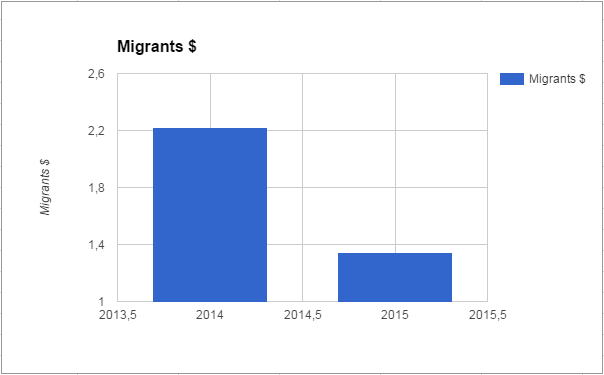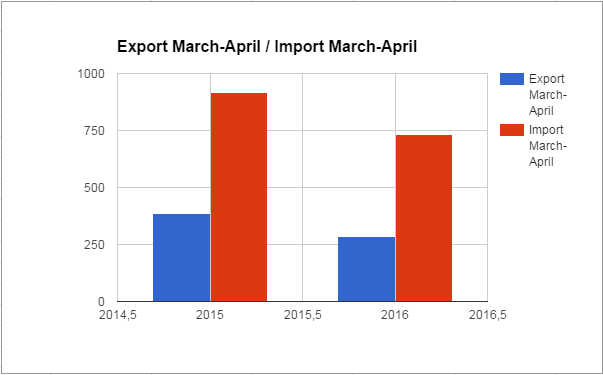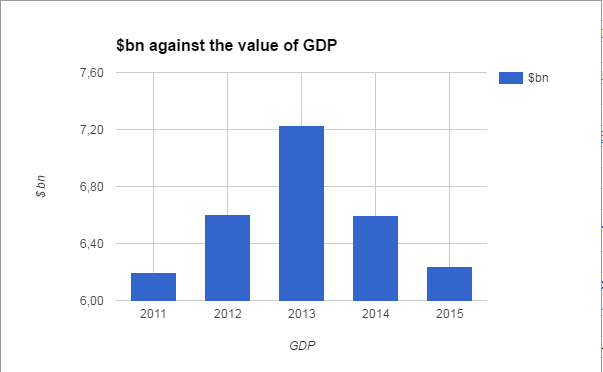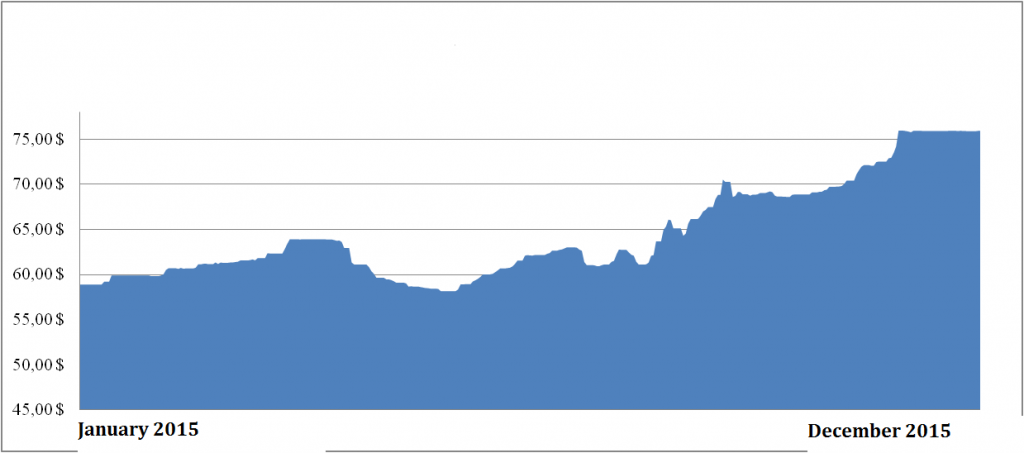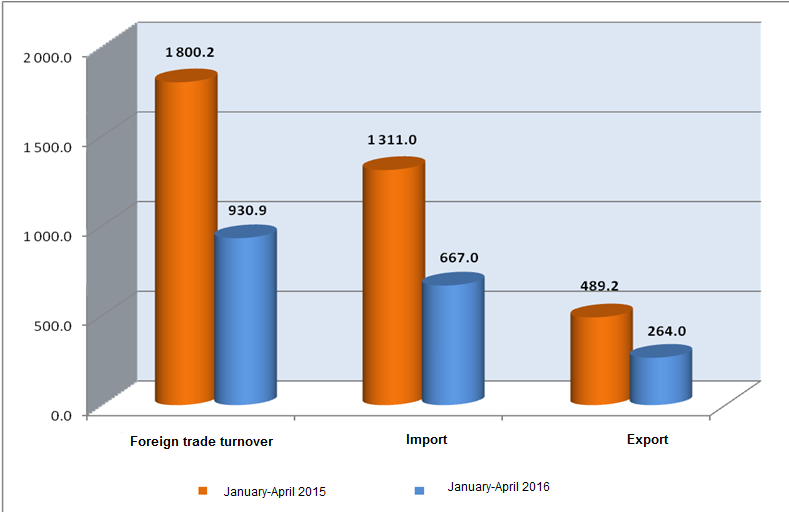“Up to date, there is no sense of a difference in the economy of the Kyrgyz Republic between the period of border closure by EAEU countries, prior to the accession, and in the period of the actual entry into EAEU. Practically, one can note that against the backdrop of international sanctions and falling oil prices, being part of EAEU is so far causing damage to the Kyrgyz Republic”, – Iskender Sharsheev, Executive Director of the Association of Foreign Investors, examines, specially for cabar.asia, the main outcomes of Kyrgyzstan’s presence in the EAEU for the last 10 months.
 Comparative economic data prior to and following Kyrgyzstan’s entry into EAEU
Comparative economic data prior to and following Kyrgyzstan’s entry into EAEU
Kyrgyzstan’s joining of the Customs Union on January 1st 2015 did not particularly influence the country’s economy. Already in 2005 and 2010, in the times of the “revolutions”, Kazakhstan would shut off its borders for trade, which caused damage to foreign economic activity, and to a certain extent was conducive to further acceleration of the country’s entry into the CU. Unification of Kyrgyzstan’s borders with CU, henceforth named Eurasian Economic Union, took place on August 12th 2015. It is precisely from that moment on that the time should be counted and statistical data considered, to observe changes in the economy of the country.
Entry into EAEU proved to be a challenge for the Kyrgyz Republic. International sanctions against Russia and the drop in oil prices, but foremost – legalization of migrants from KR in RF, as a consequence of the so called lighter conditions for an allied country, led to the impossibility to avoid taxation for the employer. This forces the Russian enterprises to opt out of hiring migrants, which, in turn impacted the migrants’ incomes and, naturally, the amount of money remittances. In 2014 the amount of migrant remittances into KR constituted $2,2193 bn1. In 2015, according to NBKR, the country received $1,344bn2. That is to say, the argument used by experts of EAEU member-states about membership in the Union as an absolute benefit and a sharp rise in the increase of the migrant remittances proved invalid.
Graph 1. Migrant remittances to KR
In comparing foreign economic activity, as shown by NSC of the KR, in 2015 the amount of Kyrgyzstan’s foreign trade fell to 23.7% compared to 2014. Export decreased by 10,7%, import – by 27.4%. In the meantime, the amount of export, discounting gold, went down to 21% due to lessening of supply of goods to the countries of CIS. Decrease of export is conditioned by the cut in the supply of clothing by 2,2 times, oil products – by 1,7 times (jet kerosene – by 1,7 times, petrol – by 27,1%), vegetable and fruit – by 34,8%, tobacco – by 27,8%.
In considering data for January-March of 2015 and 2016, the timeframe before the entry into EAEU and the period following the entry into EAEU, the picture of foreign economic activity is as follows: value of foreign trade in 2015 constituted $1302,2 mln, discounting gold – 1037,0. And in 2016 FEA’s turnover comprised $1021,0 mln, discounting gold – 921,8. There is an obvious drop by 279 mln USD.
Graph 2. Foreign economic activity of the Kyrgyz republic
Import in 2015 totaled at $915.1mln (906.1, discounting gold), while in 2016, within the same period – $733.9mln, with no import of gold. Export for the same period in 2015 came up to $387.1mln (130.9 without gold), and in 2016 – $287,1mln (187.8 discounting gold). There is an evident fall by 100mln USD after entry into EAEU. The argument of the expert-supporters of the Eurasian economic integration, that upon entry into the union a sharp increase in export of goods from Kyrgyzstan to member-states would occur, for the time being also proved invalid. Foreign trade net for January-March 2016 constituted -446.8mln USD (minus four hundred and forty six, and eight), or -546.1, discounting gold.
The impact on annual GDP, as totaled in 2015 was – $0.36bln. In 2014, the GDP, based on World Bank data comprised $6,60bln. But in 2015, the GDP dropped to $6.24bln.
Graph 3. Dynamics of GDP in KR
Furthermore, when calculable in Kyrgyz som, the GDP showing may look bright: thus in accordance with the Kyrgyz government’s argument, the budget of the country has grown. Acquisition, compared to a similar period of 2014, increased by 6025.2mln KGS, or by 3.9%. However, considering the fact that as of 1 January 2015, KGS was rated 55 KGS per $, then by 1 June 2016, the rate of KGS became 68 per $. Within that whole period, devaluation of the national currency constituted 23%.
Graph 4. Dynamics of dollar exchange rate against KGS
Dollar exchange rate against KGS 2015
But one has to bear in mind the inflation, which can make serious alterations to the situation with rising taxes, grants, loans and fees in the state budget. In 2014, inflation, according to NBKR, rated 10.5%3 while in 2015 it went down to 3.4%4. In all fairness, it has to be noted that in 2016 the prices for foodstuffs such as grain, flour, potato, and pastries went down by 30% in comparison with previous years, which is related to the lack of marketing opportunities of these goods within EAEU, due to the presence of nontariff barriers, and unhindered import of their cheaper analogues from EAEU into the Kyrgyz Republic.
As for the public debt of the Kyrgyz Republic of December 31, 2014, it amounted to $ 3 647 million5. As of December 31, 2015 the size of the public debt of the Kyrgyz Republic amounted to 3 805.1 million US dollars. The ratio of public external debt to GDP was 54.8%. the state of the external debt indicates that the country is gradually being seizes by the “Greek disease”. Almost every Kyrgyzstani on average owes $600 to the international financial institutions.
The volume of total external assistance to Kyrgyzstan amounted to $7 billion 598.2 million6. The largest donors for the country are ADB, the World Bank, the IMF, the European Bank for Reconstruction and Development, the governments of China, Japan, Germany, Turkey and Russia. This funding is spent on transport (28%), energy (21.9%), agriculture (11.2%) and social services (6.5%). One of the entry conditions into the EAEU was funding through the Russian-Kyrgyz Development Fund of infrastructure projects, namely the construction of the cascade of Kambarata HPP in the amount of up to $2 billion, Russian military aid to the Kyrgyz Republic for $1 billion. RKDF was established and operates in accordance with the Agreement between the Government of the Kyrgyz Republic and the Russian Federation “on the development of economic cooperation under the Eurasian economic integration” of 29 May 2014 and the Agreement between the Government of the Kyrgyz Republic and the Russian Federation “on the Russian-Kyrgyz development Fund” of 24 November 2014. However, with the beginning of 2016, Russian Federation refused to finance the HPP cascade in Kyrgyzstan. In this connection, a speech7 was made by the President of the Kyrgyz Republic, Atambaev, with a statement about the need to seek another investor. On the question of implementation of the RKDF8 mission things also turned out ambiguous. The fund, the capital of which had to be up to $1 billion and allotted by the Russian side, in fact placed 90% of its assets in bonds and deposits of Russian banks. The fund’s money did not reach the Kyrgyz Republic to the fullest extent.
Problems within the EAEU and implications for the KR
To date, the Kyrgyz Republic appeared simply not ready to join the fierce competition regime with countries having a high level of intervention in the economy. Having previously high revenues from hydrocarbons, Russia and Kazakhstan for many years subsidized agriculture, and have gained a high advantage over the KR in terms of output to Kyrgyzstan’s market of cheap foodstuffs, forcing many domestic companies to seek a way out of the situation or minimize their activity. As a result, the country is experiencing a serious reduction in SME manufacturers of processed food products. Serious damage to agricultural enterprises is underway. Products such as soy and potato are facing marketing problems, which, for example, cost 8-15 rubles in Kyrgyzstan, and 3-6 rubles in Russia and Belarus.
At that partners-states of EAEU launch local trade wars against KR: on May 5, 2016 a quarantine9 border control found on a passenger of a train “Bishkek – Moscow” seedling of bell pepper without a phytosanitary certificate. During inspection at the “Iletsk-1” station the control found larvae of the western (Californian) flower thrips, which is subject to quarantine. Another fact – in the potato from Kyrgyzstan, Kazakh sanitary services found infected quarantine objects – golden potato nematode Globodera rostochiensis (Wollenweber) Behrens. In this regard, Kazakhstan, employing the provisions of the Treaty on the Eurasian Economic Union, the International Convention on Plant Protection, introduced on May 4, 2016 a temporary ban on the import of potatoes from Kyrgyzstan10. The Kyrgyz side denies the fact of detection of contaminated products in the imported potatoes into RK11. It should be noted that one of the conditions of accession of the Kyrgyz Republic to the EAEU was the removal of phytosanitary control on export products from Kyrgyzstan into EAEU countries. On November 18, 2015 the phytosanitary control was withdrawn for 2 years12. But this fact did not prevent Kazakhstan and Russia subject agricultural products from the Kyrgyz Republic to phytosanitary control and introduce various non-tariff barriers to its import.
It is worthy of particular notice that 36 technical regulations of EAEU entered into force on the territory of the Kyrgyz Republic. Many technical regulations to a certain extent affect the standards of HACCP and ISO (International Standards required to maintain food quality and safety, providing laboratory cleanliness, protection from pests and minimize damage to health of food consumers). On average, expenses may be incurred from $ 17 thousand to $ 60 thousand and above in the recruitment of accredited consultants and implementation of quality control and food safety. Such amounts are not always available to small and medium businesses in the Kyrgyz Republic that are engaged in the production and processing of food products. Until now there are no more than three dozen companies in the food industry in the country, having ISO certificates. There are fears that before the end of the memorandum, almost all small and medium-sized food businesses in the country will be outlawed, due to inconsistencies of technical conditions of enterprises with regulations of EAEU.
There is not yet a single fully-equipped laboratory available in the Kyrgyz Republic, through which to obtain declarations of conformity to technical regulations of EAEU. Kazakhstan planned to allocate to the KR 100 million US dollars to set up laboratories for certification of food products13. At the moment, the fate of the grant is not clear just as the level of readiness of laboratories to conduct activities on technical regulations of EAEU.
Unfriendly attitude has also been noted, in particular on the part of Kazakh citizens with regard to cross-border trade in relation to citizens of the Kyrgyz Republic14. In the markets of Almaty and Astana raids are being launched, and if traders from Kyrgyzstan are identified, tests are immediately conducted, followed by termination of the right to trade. Along with the inspections, penalties have also been increased, as well as the illicit exactions five times over.
Another problem is the lack of mechanisms for the protection of the Kyrgyz Republic from smuggling of goods from Kazakhstan, Russia and Belarus. Experts estimate that about 30% of fuels and lubricants consumed by Kyrgyzstan is imported into the country illegally. During January 2016 the volume of official imports of petroleum products decreased by 26 thousand tons in comparison with the same period last year15. For the period of 1st to 15th of February, the reduction of official imports amounted to 9 thousand tons. As a result, the state budget did not receive more than 340mln soms of taxes (200 million excise duty and 140 million of value added tax). The same situation is present in the import of hygiene items, soap and detergent products, flour, sugar, bakery products, confectionery and cereals. The government attempted to respond to the situation by introducing tax-posts, which caused a reverse reaction from the Kyrgyz business community.
In connection with the introduction of the Russian Federation’s tax on large-load vehicles, known as “Plato”, which foresees payment of 1.53 rubles per kilometer16, transport companies of the Kyrgyz Republic (e.g. such as “Zamat Cargo”) were forced to suspend their operations, which resulted in the rise of prices for exports of garment and textile products from Kyrgyzstan to Russia and Kazakhstan.
Upon entry into the Customs Union, and then to the EAEC, the Kyrgyz Republic was to receive its share of EAEU customs duties17. The Calculated volume of imports from third countries on the basis of “UN Comtrade” statistics (with amendments) has allowed to establish the amounts of distribution ratios of import duties for each party in as following:
– Armenia – 1.1%;
– Kyrgyzstan – 1.9%;
– Belarus – 4.70%;
– Kazakhstan – 7.33%;
– Russia – 87.97%.
Graph 5. State customs service statistics
From the date of entry of the Kyrgyz Republic into EAEU (Eurasian Economic Union) the volume of mutual trade with Armenia, Belarus, Kazakhstan and Russia, while being at the same time members of CIS and EAEU do not reflect in statistical data.
During October-December 2015, Kyrgyzstan received 3.5 bn. som from the splitting of the EAEU customs duties18. In 2016, it is being planned to receive 18 billion som in payments from the EAEU. The 2016 customs plan envisages 32 billion, 176 million som19. Of these, 14 billion 185 million som are in tax payments and 17 billion 981 million -..the duty from the EAEU countries. At that, it should be remembered that the customs duties revenues to the national budget of Kyrgyzstan in 2014 amounted to 42 billion 580.2 million som20. The effect of many factors, including the decline in oil prices, but most of all – the unification of the Kyrgyz customs borders with the EAEU, leads to the loss by the Kyrgyz Republic of more than 10 billion soms of customs duties. That is, compared to previous years, as a result of joining the EAEU, state revenues from customs duties fell by 23%.
Furthermore, the partners in the EAEU, note the Kyrgyz Republic representatives’ low activity in the development of EAEU laws, legal acts and in the conduct of regulatory impact analysis of the EAEU bills. Supranational authorities in the EAEU have been established. On the part of Kyrgyzstan, the position of the board member of the EAEU (the Minister) until recently have been held by Ibraev Danil Tursunbekovich. Also, the former head of the secretariat of the National Alliance of Business Associations (NABA,) Uluk Kydyrbaev, have been included in the working group of the Eurasian Economic Commission (EAEC) on the assessment of a regulatory impact of EAEC draft decisions, for 4 years. According to the latter, the Kyrgyz business community is extremely passively involved in the protection of their rights in the formation of the EAEC legislation.
Conclusions
As a result, it is possible to draw a number of conclusions based on the results of economic activity of the Kyrgyz Republic within the framework of the Eurasian Economic Union over a period of 10 months, from August 2015 to May 2016:
The Kyrgyz Republic was not ready economically, technically and financially, to join the Customs Union and the Eurasian Economic Union. Entry was dictated rather by political arguments than economic calculations.
The Kyrgyz Republic came to be a party harmed in the fact of a noncompliance with the conditions of joining the Eurasian Economic Union. The following conditions have not been met:
The building and funding of the hydroelectric power station cascade promised by the Russian Federation did not take place;
- No full support by EAEU countries in providing a leeway for Kyrgyzstan on the factual lifting of the phytosanitary control on agricultural products for 2 years have been given;
- EAEU countries do not provide conditions for freedom of movement of capital, labor force, goods and services from the Kyrgyz Republic into EAEU countries, despite the fact that the Kyrgyz Republic provides those freedoms for EAEU countries.
The situation of labor migrants from Kyrgyzstan in EAEU countries allows for the legalization, but the very essence of the legalization of labor resources from Kyrgyzstan imposes higher tax liabilities on the employer companies in EAEU countries, as a result employers in the EAEU tend not to hire migrant workers who want to work legally. This fact reduces the attractiveness of EAEU labor markets for Kyrgyz citizens, and in fact leads to a reduction in remittances into Kyrgyzstan.
Currently, the Kyrgyz Republic has no tangible advantages of joining the EAEU, the pros are only declared and designated in prospect. For example, Kyrgyzstan received the status of GSP +21, and can become a window into the EU for producers in EAEU countries. Also, the business community in the Kyrgyz Republic has been thrown the gauntlet – either raise the quality of the products and certify them according to international standards or cede the internal market for businesses expansion of partner countries of EAEU. At the moment, no pros have materialized.
At present, one cannot state that joining the EAEU has benefitted the Kyrgyz Republic. Perhaps the situation will change over time. But today, there is no sense of a difference in the economy of the Kyrgyz Republic between the period of border closure by EAEU countries prior to the accession, and during the actual entry into the EAEU. Practically, it may be noted that against the backdrop of international sanctions and falling oil prices, being part of the EAEU, is so far causing damage to the Kyrgyz Republic. Perhaps this is a friction and a due occurrence in the initial stage of the integration process. But this, only time will tell.
Sources cited:
- Remittances from Russia to their homeland decreased due to unstable position of the ruble and a seasonal decline. 19.02.15 // http://ru.sputnik.kg/migration/20150219/1014415081.html
- Kudryavtseva T. In 2015, migrant remittances to Kyrgyzstan decreased by $ 500 million // 03.01.16 http://24.kg/finansy/28503_v_2015_godu_obyem_perevodov_v_kr_ot_trudovyih_migrantov_snizilsya_na_500_millionov/
- Kudryavtseva T. In 2014, inflation in Kyrgyzstan totaled 10.5 percent 15.01.15 // http://24.kg/ekonomika/4897_v_2014_godu_inflyatsiya_v_kyirgyizstane_sostavila_105_protsenta/
- Kudryavtseva T. In 2015, inflation in Kyrgyzstan rated at 3.4%. // 14.01.16
http://24.kg/ekonomika/25996_v_2015_godu_inflyatsiya_v_kyirgyizstane_sostavila_34_protsenta/
- Tsoi M. Kyrgyzstan’s foreign debt amounts to almost half of the GDP 30/04/13. // http://www.vb.kg/doc/226539_vneshniy_dolg_kyrgyzstana_sostavliaet_pochti_poloviny_vvp.html
- Kudryavtseva T. The volume of total external assistance to Kyrgyzstan amounted to $ 7 billion 598.2 million. 09/10/2015. // http://24.kg/ekonomika/20577_obyem_sovokupnoy_privlechennoy_vneshney_pomoschi_v_kyirgyizstan_sostavil_7_milliardov_5982_milliona/
- REVIEW: THE PROBLEMS OF CONSTRUCTION OF THE HIDROPOWER STATION IN KYRGYZSTAN 25.12.15 // http://www.ca-portal.ru/article:24107
- Russian-Kyrgyz Development Fund. Unused capacity 24.03.16 // http://capital.kg/capital-diary/rossijsko-kyirgyizskij-fond-razvitiya.-neispolzuemyij-potenczial
- Morozov N. IN RUSSIAN ORENBURG BELL-PEPPER IMPORTED FROM KYRGYZSTAN WAS DISTROYED // 11.05.16 http://aspnova.ru/novosti-mira/v-rossiyskom-orenburge-unichtozhili-zavezennyiy-iz-kyirgyizstana-bolgarskiy-perets/
- Kazakhstan introduced a temporary ban on the import of potatoes from Kyrgyzstan // 04.05.16
https://tengrinews.kz/kazakhstan_news/kazahstan-vvel-vremennyiy-zapret-vvoz-kartofelya-293822/
- Muratalieva A. Kyrgyzstan denies import of contaminated potatoes 06.05.16. // http://kloop.kg/blog/2016/05/06/kyrgyzstan-otritsaet-vvoz-zarazhennogo-kartofelya-v-kazahstan/
- MINISTER A. KOZHESHEV IN BATKEN OBLAST: ON THE CREATION OF FAVORABLE CONDITIONS FOR BUSINESS 24.02.16 // http://mineconom.gov.kg/index.php?option=com_content&view=article&id=5858&catid=63&lang=ru
- On the readiness of Kyrgyzstan’s laboratories to cooperate within the framework of the EAEU 10.06.15 // http://rus.azattyk.org/a/27119860.html
- Glushko S. Kyrgyz workers complain that they are trade in Almaty is being thwarted 20.03.12 // http://rus.azattyq.org/a/kazakhstan_kyrgyzy_migrants_/24521246.html
- Kutueva A. Kyrgyzstan in the EAEU: contraBAND is advancing 09.03.16 // http://rus.azattyk.org/a/27599908.html
- Raspopova A. Creditable “Plato» 09.02.16 // http://www.gazeta.ru/auto/2016/02/09_a_8065115.shtml
- NISR clarified how the calculation of Kyrgyzstan’s share was made during the fragmentation of customs duties of the EAEU countries // 04.11.15 http://berlek-nkp.com/news/4355-nisi-razyasnil-kak-proizvodilsya-raschet-doli-kyrgyzstana-pri-rasscheplenii-tamozhennyh-poshlin-stran-eaes.html
- Kyrgyzstan received 3.5 billion soms from customs duties of EAEU // ru / sputnik / kg | economy | 20160204 | 1022122191 / html
- KR will receive 18 billion soms from the fragmentation of customs duties of EAEU 04.02.16 // ru / sputnik / kg | economy | 20160204 | 1022126395 / html
- Income of customs duties into the national budget of Kyrgyzstan in 2014 amounted to 42 billion 580.2 million soms // 01.09.15 http://rus.kg/news_rus/economy_rus/32274-postupleniya-tamozhennyh-platezhey-v-respublikanskiy-byudzhet-kyrgyzstana-v-2014-godu-sostavili-42-milliarda-5802-milliona-somov.html
- Kyrgyzstan has become a user of EU’s “Generalized System of Preferences +” 09.02.16 // http://www.ictsd.org/
Author: Iskender Sharsheev, executive director of the Foreign Investors Association (Kyrgyzstan, Bishkek)
The views of the author may not coincide with the position of cabar.asia
Graph 1. Migrant remittances to KR


